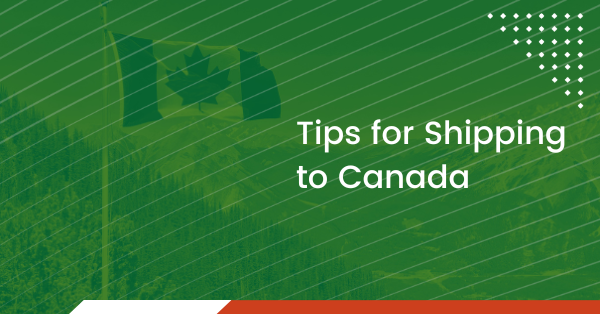As the northern neighbor to the United States, Canada is the first-place companies typically look into when exploring new export territories. However, joining a foreign market is often more complex than most firms anticipate. Understanding market differences, navigating customs duties, and managing what it means to be a non-resident importer can be challenging in a foreign market. Thankfully, conquering Canadian retail is possible when following best industry practices. Below, PLS Logistics Services has gathered a few tips to help businesses manage shipping to Canada.
The Essentials for Shipping to Canada
Canadian Paperwork
As you can imagine, moving freight to Canada requires additional paperwork compared to domestic shipping. When conducting business across the border, you need three pieces of paperwork: a bill of lading (BOL), a Canadian Customs Invoice, and a NAFTA certificate of origin. It is essential to ensure all your documentation gets correctly completed to avoid delays in transit and delivery. Working with a customs broker or logistics provider on this paperwork increases accurate shipments and reduces delays and damage. Some carriers even require it before they accept your freight for shipment.
Pre-Screening Procedures
Pre-screening procedures alleviate lags when crossing the border. Since 2013, Canadian customs have required all shipment information before the freight arrives at the border. As a result, the driver does not have to wait in already-long lines and can present an Advanced Commercial Information (ACI) eManifest card to cross the border. For a shipper, shipments must be scheduled in advance and in collaboration with the carrier to ensure all paperwork is done and completed correctly.
Navigating Multiple Freight Quotes
Multiple freight quotes can be difficult, especially when numerous national borders are involved. Cross-border freight quotes can be tricky given that there are various cost-related factors to consider, including currency exchange rates. The quickest and easiest way to request several quotes is through an online platform, preferably with companies offering simple rate structures such as uniform pallet pricing. Online quote request services work exceptionally well with LTL freight and can save your company money, hassle, and time in shipping.
Palletized Packaging
Different countries have varying packaging standards, as well. Palletized freight is the standard shipping method, but it must follow general guidelines when moving internationally. First, the wooden pallets must be heated or chemically treated with methyl bromide when moving across borders. Wood must also be marked with an ISPM 15 stamp. While these requirements may seem nitpicky, these regulations protect against wood-boring pests or seeds that could harm a new environment. Freight shipped on improper pallets or packaged improperly will be denied or could even get destroyed by border agents.
Insurance
Shipping freight to Canada is expensive, so it may be tempting to skip the insurance costs. However, paying a little extra to ensure your shipment and protect yourself from fines and the potential for damaged products will prove helpful in the long run. Many carriers include basic insurance in their base rates. However, additional insurance is readily available from an independent provider elsewhere if you’re searching for extra protection.
In addition to insurance, most carriers and logistics companies offer online tracking services, which allow you to monitor your freight while in transit and notify you of its delivery. Access to advanced tracking services will enable you to quickly be alerted if something happens to your load so you can inform your customer early. Visible customer service and quick response times help make you a preferred business amongst customers.
Precautions to Take When Shipping to Canada
Know the Market
While the United States and Canada are close countries in proximity, there are fundamental cultural differences to recognize as an American entering a foreign market. Understanding differences in language, work habits, education, religion, and more will help you provide the best products to your customers.
Every consumer-based culture has different shopping and purchasing habits. For example, Canadians tend to be more responsive to loyalty programs and low pricing than coupons and promotions.
Check Your Customs Checklist
Labeling and Packaging Requirements – products entering Canada have extensive marketing and labeling requirements mandated by federal and providence law. Before shipping, ensure you understand the Consumer Packaging and Labeling Act. This act has many regulations, including requiring all labels to be in English and French.
To conduct business in Canada, it’s critical to understand the country’s unique tax code. Taxes are collected at the federal and provincial government levels, so double-check each region’s tax rate when completing calculations.
Always Check with Your Carriers
The common misconception is that companies handling U.UShipments can seamlessly transition into Canadian shipments. The reality is that the U.USnd Canada have different required expertise, so it’s crucial to find a provider that can perform the following services:
- Customs Clearance – a provider should have resources to guarantee compliance with all U.USnd Canadian customs mandates.
- Distribution Network – Canada has a combination of urban and remote areas. The right provider should be able to ship to all locations without having to offload to a third party.
- Canadian Expertise – Canada has vastly different regulations compared to the U.USt will prove invaluable to have a shipper with preexisting Canadian expertise, saving you the time and money in investing your resources.
Shipping to Canada with PLS
Shipping internationally can be complicated; at PLS Logistics, we are dedicated to helping you. To start, get a free quote with us today so that we can assist you. When you’re looking to move freight across the USUS Canadian border, do not hesitate to ask for professional help. Protect your cargo through an experienced third-party logistics provider and team up with PLS Logistics Services.

